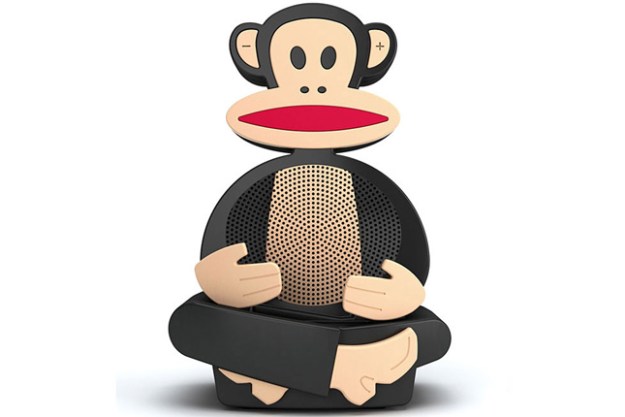
“For a first-generation product, the Julius Dance Machine is a fine attempt, but there are several things SpeakerCraft and Paul Frank can do to improve upon it.”
- Quality construction
- Solid mid-range
- Built-in battery
- Distortion at high volumes
- High-pitch squeal and white noise (poor shielding)
- iPod adapters or aux cable not included
- Lacks play, pause, skip controls on the dock
Fashion designer Paul Frank has been on a tear lately, stamping the iconic Julius the Monkey over everything from rain boots and bedding for kids, to bicycles and infant bibs. Not to be outdone in the world of tech, Paul Frank has teamed up with esteemed home audio company SpeakerCraft to create a Julius the Monkey iPod speaker dock. But as tech enthusiasts know, not just any brand can burst onto the tech scene and expect to make it past our discerning eyes. Afterall, this isn’t a $2 zipper pull we are talking about, but a $99 dollar piece of tech.
 Features and design
Features and design
Staying true to form, the Julius Dance Machine looks like, well, a monkey. Sitting cross-legged with open arms waiting to snuggle the Apple iPod of your choice, this dock is anything but serious. But it doesn’t feel like a novelty. Like a high-end BMW dashboard, the silky matte-finish plastic has a very high production quality to it. None of the body parts flex or creek when handled, and the paint job is better than we have seen on other iPod docks.
There are basically three controls on the dock itself for you to use. The power button is located on the head, and each ear acts as a volume control. Nestled in the lap of the monkey is the iPod connector, backed by a metal brace to prevent damage to the Apple iPod while you are pushing buttons. Paul Frank touts the Julius Dance Machine as supporting interchangeable iPod adapters for a better fit, but unfortunately none come included (just the standard plate). Different iPod cases also had trouble fitting. What a shame. Other omitted features include a remote control or any playback control buttons on the dock itself. Instead, you are forced to push the buttons (play, pause, fast forward, rewind), on the iPod while it’s docked. Strange.
On the bright side, Paul Frank does include a built-in rechargeable battery with around five to six hours of battery life. Also included is an auxiliary input, in the event that you want to connect a non-Apple MP3 player to the Julius Dance Machine. But again, an auxiliary cable is not included (not necessarily a big deal).
 Sound quality and testing
Sound quality and testing
Getting the Julius Dance Machine up and running it very straightforward. Snap in the connecter base and plug in your Apple iPhone or iPod. Once plugged in, the base will start charging the iPod and let you play music right away. The Julius Dance Machine puts out good sound detail at normal listening volumes thanks to the SpeakerCraft drivers within. The product manual doesn’t mention the size of the driver, but if we had to guess, we would put it at about 4 inches — maybe smaller.
Midrange is nice and warm, highs are present, but flat, and bass is echoy and hollow, not exactly deep. At high volumes, we noticed considerable distortion, making the Julius Dance Machine more suitable for sitting on a bed stand in a child’s room rather than out in the front room for use at a dinner party (depending on how silly you want to be).
We noticed that while the unit is plugged in but powered off, we could hear a high-pitched squeal that became very annoying up close – and that is with the iPod removed from the dock. With the iPod mounted, but without music playing, we could hear a lot of static noise. So just to make sure, we requested a second unit be sent for testing purposes. This is clearly a sign of poor shielding in the construction of the unit.
Controlling your iPod while docked is straightforward, albeit a little messy. For wider Apple iPods like the Classic, you have to navigate your fingers around the monkey’s hands to get to the next and previous buttons. If you want to pause your music, you have to fit your finger into the base of the unit to find the button on your iPod. The designers could have simplified things by putting more controls built into the dock itself. Perhaps the Monkey’s hands could be the previous and next buttons? Just a thought.
Conclusion
The Paul Frank Julius Dance Machine iPod Dock is a fun product to have sitting around the house, and is sure to be the center of attention for many conversations. For a first-generation product, the Julius Dance Machine is a fine attempt, but there are several things SpeakerCraft and Paul Frank can do to improve upon it. We were hoping that the speaker would have been a little better quality for the price, and the distortion is pretty inexcusable in our book. Paul Frank might be a minimalistic designer, but in the world of tech, even the most basic controls are required.
Buy the Julius Dance Machine for its looks, not for its sound, and you will be a happy customer.
Highs:
- Quality construction
- Solid mid-range
- Built-in battery
Lows:
- Distortion at high volumes
- High-pitch squeal and white noise (poor shielding)
- iPod adapters or aux cable not included
- Lacks play, pause, skip controls on the dock




